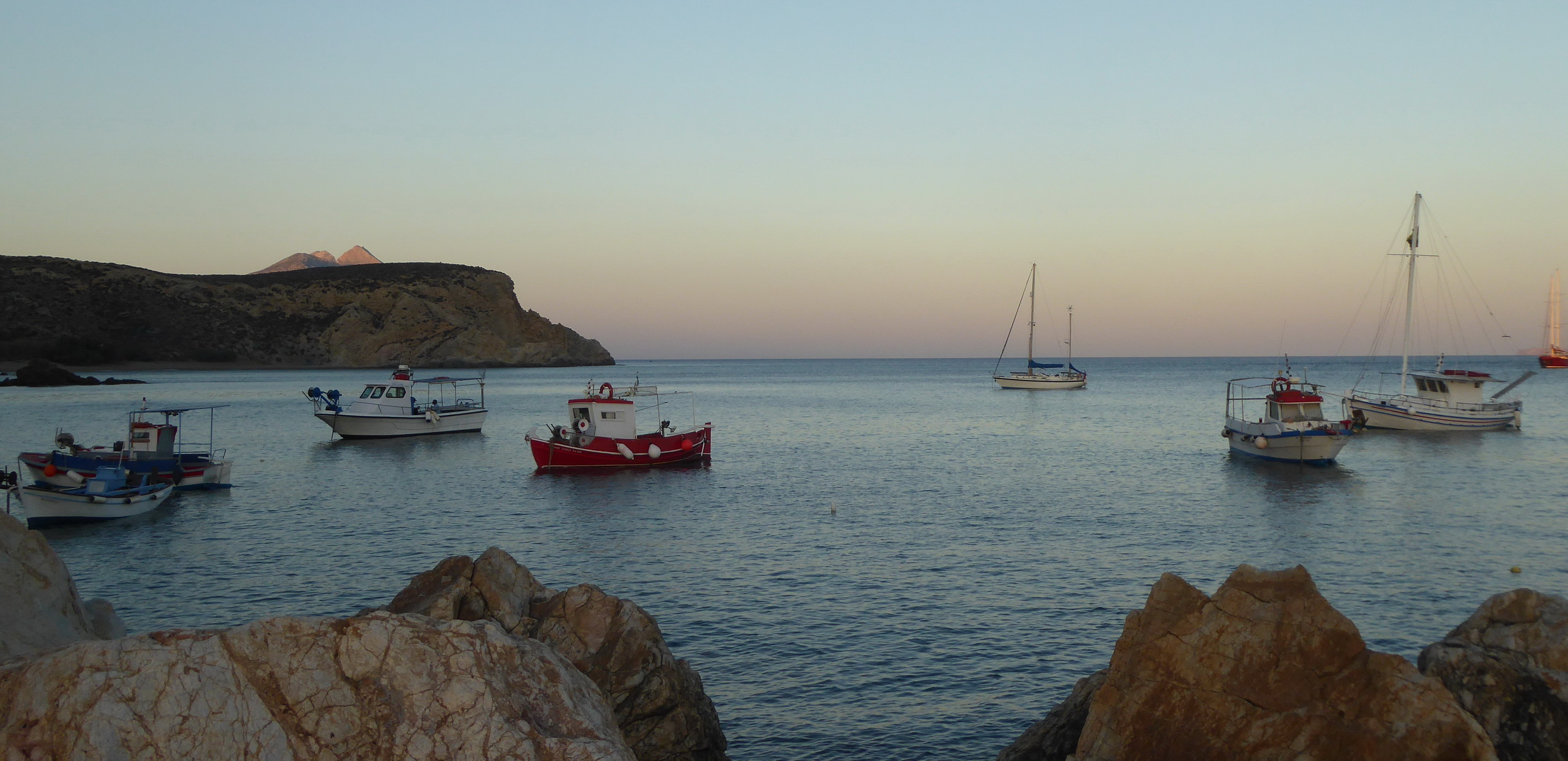June 2015 : Southern Cyclades and Peleponese
LaterEarlier |
We are now in Navplion at the far north of the Argolic Gulf on mainland Greece, having completed a tour of the idyllic islands of the southern Cyclades from east to west and thence to the eastern side of the Peloponnese – not far from where we departed to Crete last autumn. We've had a great month – climbed a lot of hills, marvelled at a lot of awesome views, explored several medieval kastros, swum in sparkling clear turquoise waters - and even done quite a lot of sailing. Julia returned to Crete from a week's visit home at the beginning of the month to find Aremiti back in the water in pristine condition and ready for action after all Chris' hard work. Friends Annie and Pete were in Aghios Nikolaos for a week's holiday and we saw them most days, taking a car trip together around the area to check out some traditional inland villages, the ancient site of Lato and a Byzantine church with fabulous frescoes. Pete then joined us for the 23 mile passage to Sitia – the eastern-most town in Crete. This started tentatively in very light winds from the wrong direction, building to an increasingly boisterous sail, ending by battling into the harbour against over 20 knot headwinds. Sitia was a delightfully old fashioned little town - unassuming and seemingly content in its own world - bars with old men playing backgammon and kids on breaks between exams and a lot of serious fishing activity. Finally, after Aremiti's 9 month stay in Crete it was time to leave if we wanted to
avoid getting pinned down there by strong winds from the north all summer. The passage
from Sitia to Astypalia is 83 miles. We timed our departure to include an overnight
stretch to arrive sometime the following morning allowing contingency for the passage
taking longer than our average, not wanting to arrive into the tight little harbour in
the dark. However, to our surprise and delight we enjoyed a rollicking sail on a perfect
beam reach all the way - hour after hour so far above our average speed that we thought
log must be over-reading.
Our next passage was another great sail - to Anafi, the southern-most of the Cycladean
Islands, by legend raised from the sea by Apollo to provide refuge for Jason and the
Argonauts in a storm. We stayed longer than planned in the enchantingly pretty
anchorage, in bright turquoise water off the harbour village with golden beaches on one
side and Chora high up above. So far tourism seems largely to have passed Anafi by,
though everywhere we encountered people painting their properties – always bright white
walls and blue woodwork – in the expectation of tourists about to arrive. It is a tiny
island with a population of just 300 and after three days there, we felt we were
beginning to know people and be recognised on our meanderings. We had 'our' restaurant -
mother and daughter owners Poppi and Nektaria, gave us roses and biscuits as we left and
the recipe for a dessert requiring over-ripe figs!
Santorini was our next destination. Though not
enthused by the likely hoardes of tourists (including us), we were looking forward to
visiting this iconic sights and planned a stay of 2-3 days in order to explore the
'real' island. However, this proved not to be possible. Our first and most hopeful
destination option was a marina at the southern end of the island, but this was
comprehensively ruled out by a curt 'no room tonight' to our enquiry. The marina was in
a godforsaken location, so we felt not too disappointed. On into the awesome six by four
mile wide caldera (formed by the mega volcanic eruption sometime between 1600-1400BC
which contributed to the end of the Minoan civilisation) with its multi-coloured cliffs
and strange rock formations, passing islands which emerged out of the water only 300
years ago.
Ever westwards - to the island of Folengandros, to anchor peacefully in the bay off the little harbour resort of Karavostasis. This time we took the bus up to the particularly lovely Chora, high up and out of sight of the port. The white and blue balconied houses in the kastro are a captivating example of the traditional Cycladean style. The main street of the newer (relatively speaking) part of town charmingly meanders through a series of shady squares. Gentrification is taking place here with chic bars and boutiques – but in mid-June, all was very quiet. Next we took a break from islands with hills and headed for a remote beach anchorage at
the south of Kimolos. The forecast was for strong winds the following day, but after a
quiet night, next morning we made the classic error of assuming that as all was quiet in
our anchorage (carefully chosen for its shelter – duh!) the forecast must be wrong. We
set off on the short passage into Milos and were soon bashing straight into a very nasty
sea. Without proper preparation, things were being thrown around inside the boat, not to
mention ourselves. However, the unpleasantness didn't last long before we were into the
quieter waters of the great harbour of Milos. This was the largest of the islands we
visited and initially appeared to have missed out on the magic of the other islands. It
had a hill top Chora and a kastro which we climbed up to, with a fantastic view of the
caldera/harbour. However, it lacked the idyllic qualities of the other islands. We
decided, rather mundanely, that this would be a good place to give the boat's topsides a
clean and polish - having been regularly swimming around the boat, we felt she was
looking a bit scruffy. This entailed a couple of days (well, mornings – afternoons are
for siesta) work. In focusing on this, we missed the opportunity of a perfect forecast
for our next leg – a long one. We regretted this as the next couple of days looked not
too good.
The following day we crept out of Milos as dawn was breaking, highlighting the brilliant colours of the craggy coastline. Our destination was Monemvasia on the mainland coast, 70 miles away. Despite a forecast of not enough wind, we sailed much of the excellent passage on calm seas. As we progressed westwards we crossed the track of several commercial vessels heading south – potentially on a collision course with a couple of them, necessitating a radio callto sort out who was going ahead of whom. We arrived into Monemvasia mid afternoon and berthed in the little harbour to find a
very different landscape. From Monemvasia we have meandered up into the Argolic Gulf. Our next stop was Kiparissi – situated against a backdrop of spectacularly craggy mountains this was a pretty and inviting looking little village. Unfortunately, due to forecast strong winds, we had to anchor further around the bay for shelter and didn't get ashore. Here we found ourselves gradually surrounded by an incoming flotilla of clearly inexperienced yacht crews – which was somewhat unnerving. One of these anchored extremely close to us becoming an issue during a boisterous squall in the middle of the night. However no damage was done, the winds gradually decreased and we all went back to sleep. On the following day we experienced the nastiest passage of the month. Entirely contrary to the forecast, we found ourselves fighting into 25-30 knots of wind in an accompanying sea of steep stopping waves. Stuff this we thought and identified an alternative destination, closer and in a better direction for us - a gorgeous secluded and deserted cove opposite the island of Spetses. We decided to stay put in this little oasis of peace until midday the next day to take advantage of forecast southerly winds to push us north to Navplion at the top of the gulf. However, mid-morning two gigantic motor-yachts arrived to entertain us. We are quite nosy when it comes to these enormous ostentatious vessels which typically anchor and start disgorging 'toys' – jet-skis, boards, etc. We checked out the larger of the two and discovered that it is for charter at a mere 85,000 – 100,000 euros per week – including of course the services of the crew of four! A cheapskate could charter the plush 30 metre sailing yacht we saw in Milos for only 46,000 euros per week – again inclusive of crew. Also in Milos was a vast motor yacht demeaningly (we felt) called Chopi Chopi. This 80 metre long, 5 deck high monster is apparently 91st largest in the world and has a fuel capacity of 250,000 litres! Fascinating! Of course, we mainly encounter yachts – from a far wider variety of countries than when we were last in these parts. French and Italian the most numerous, followed by British and Germans and Dutch - a sprinkling of Belgians, Norwegians and Austrians, plus Polish, Russian, Bulgarian, Lithuanian, and Slovenian. The forecasters redeemed themselves for this final passage of the month with a spot on
prediction giving us a delightful sail up to Navplion – a town of elegant Venetian
mansions and leafy squares, posh boutiques and plenty of places to eat out. The weather has been good to us so far. Apart from a couple of blips we have led a
charmed life, watching forecasts of winds howling down the Ionian to the west of us and
the Turkish side of the Aegean to the east of us, leaving us in relative calm. However,
this could all change - stormy weather may be ahead as we move into July, with the
meltemi in full sway as we attempt to progress northwards. Indeed, as we write, forecast
strong winds seem likely to hold us up for a few days, so we are seeking out a snug
anchorage to hide away for the next few days. Stormy times for the Greek economy too
with banks closed and the Referendum in a few days. We are fine – but people we talk to
here are confused and depressed, believing that whatever the result, things will
inevitably get worse for them.
|

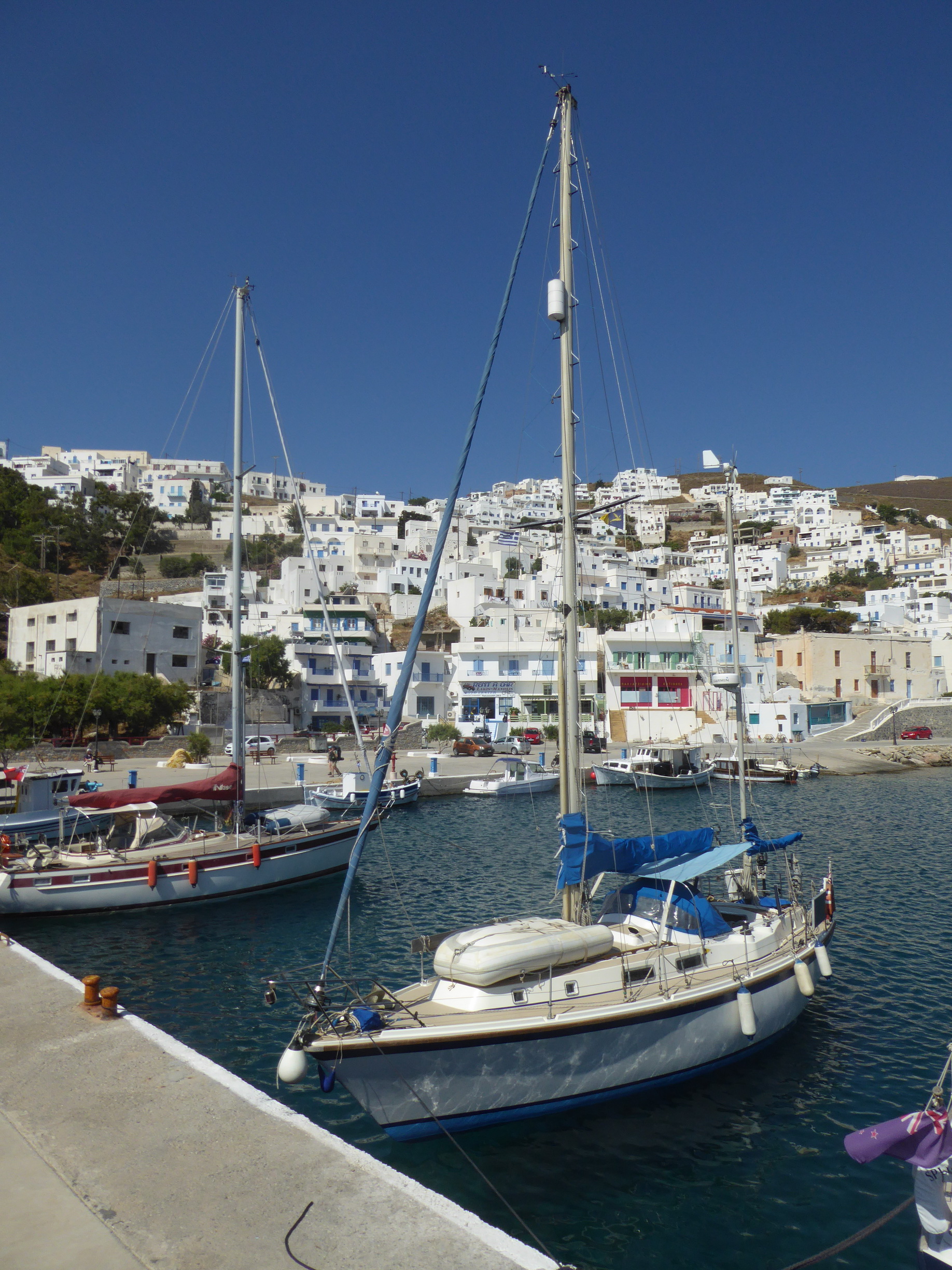 We arrived at 3.30am and anchored in a deserted bay next to
the harbour – the floodlit view of the Chora and Kastro reminding us of our last visit
to Astypalia 13 years ago. We had very fond memories of the island from that earlier
visit and enjoyed a nostalgic couple of days reviving them, wandering up to the Kastro
at the top of the Chora (main town) with its narrow streets of bright white and blue
houses, and windmills, spilling down to the Skala (harbour).
We arrived at 3.30am and anchored in a deserted bay next to
the harbour – the floodlit view of the Chora and Kastro reminding us of our last visit
to Astypalia 13 years ago. We had very fond memories of the island from that earlier
visit and enjoyed a nostalgic couple of days reviving them, wandering up to the Kastro
at the top of the Chora (main town) with its narrow streets of bright white and blue
houses, and windmills, spilling down to the Skala (harbour). 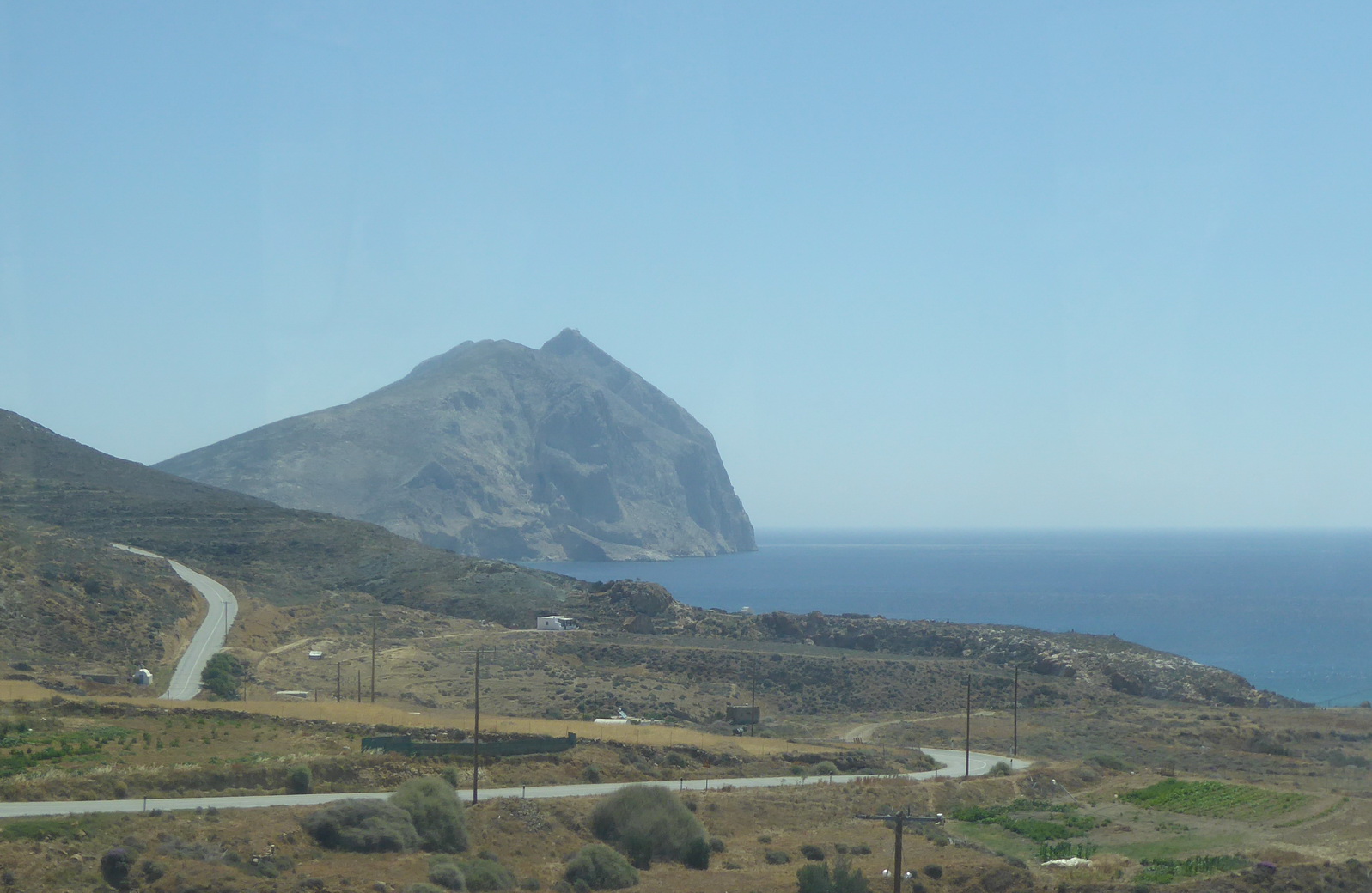
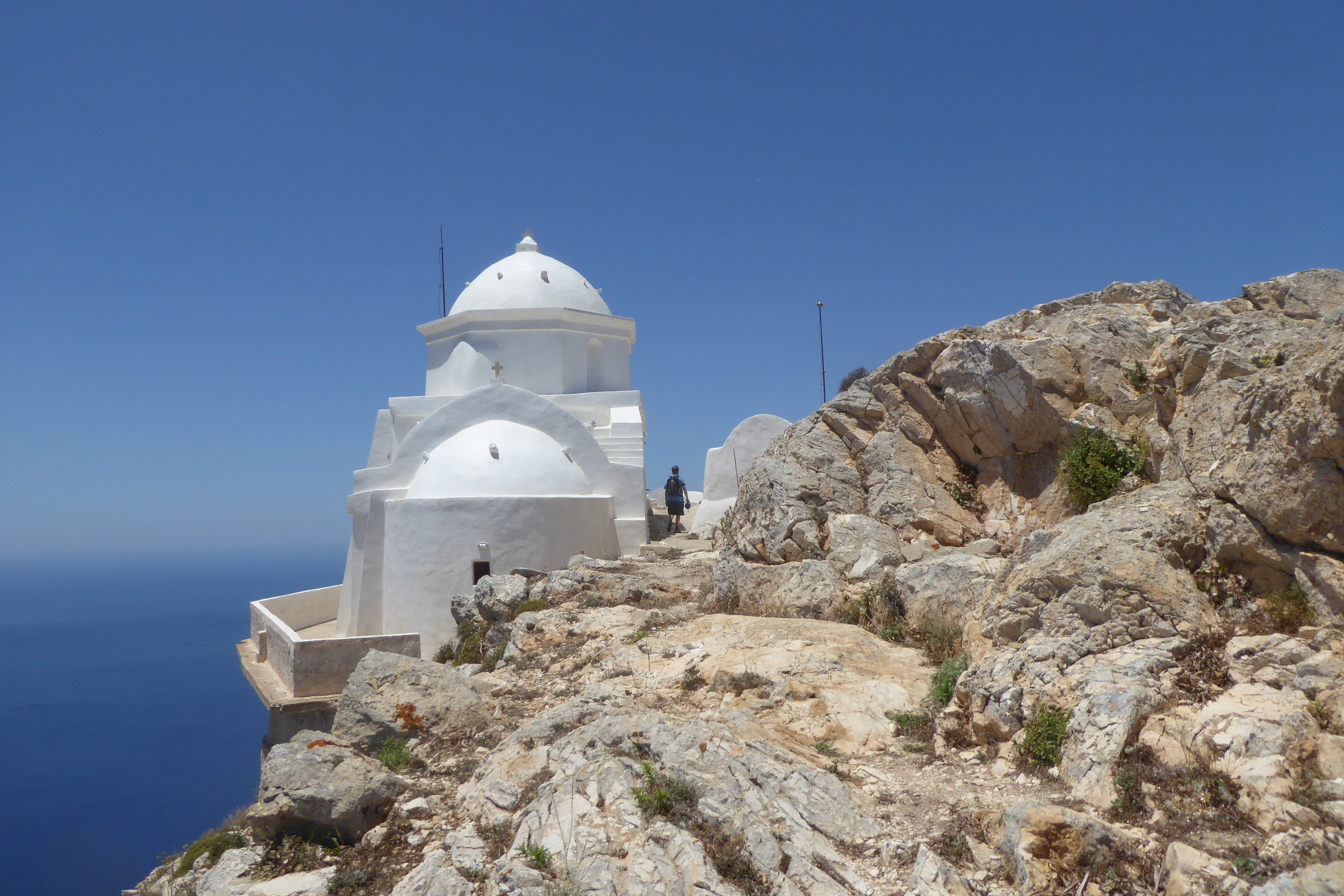 At one end of the island is the
highest rock formation in the Mediterranean – even higher, at 470 metres, than
Gibraltar. This of course had to be climbed right to the small monastery at the top.
Tough walk, but hugely rewarding with stunning views – southwards into a blue haze where
Crete must be and westwards to Santorini.
At one end of the island is the
highest rock formation in the Mediterranean – even higher, at 470 metres, than
Gibraltar. This of course had to be climbed right to the small monastery at the top.
Tough walk, but hugely rewarding with stunning views – southwards into a blue haze where
Crete must be and westwards to Santorini.
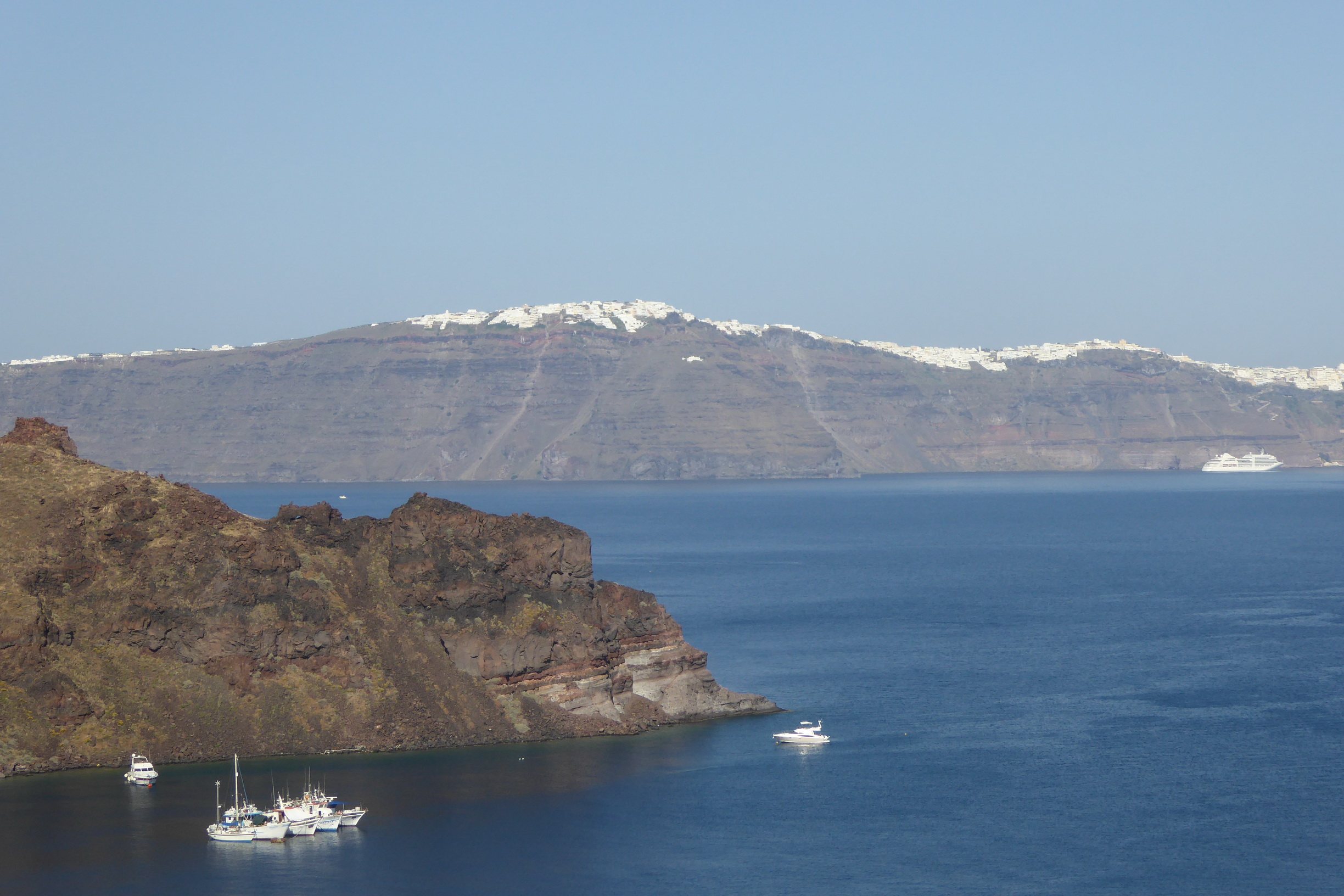
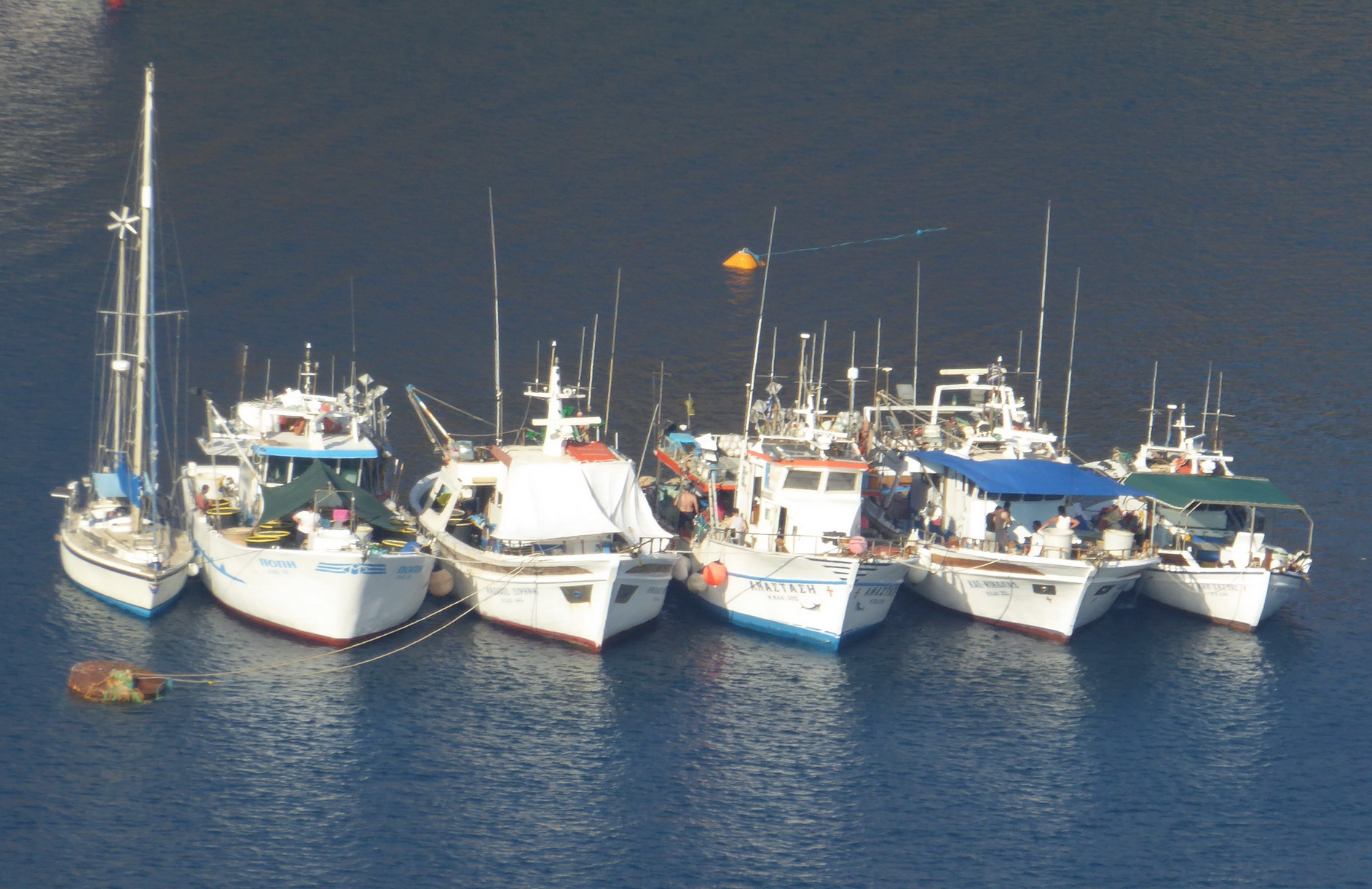 At one end of the island is the
We arrived at the quay at the bottom of the 200 metre high cliffs on which
perches the capital – Fira – like a dusting of snow. No good here either – unless we
didn't mind being bashed to pieces against the quay from the wash of numerous jolly
boats rushing back and forth from the four cruise ships lurking offshore. Their
presence, adding another 8,000 or so passengers to the island's visitors, was beginning
to put us off. However, we headed off to our final hope – the island of Thirassia – a
separated part of the caldera rim, opposite the main island. Our hopes of anchoring
there were dashed when we could find nowhere shallower than 50 metres up to within a
very few metres from the shore. However, encountering a 'flotilla' of five fishing boats
moored to a gigantic buoy, we yelled a request to join them. We were welcomed alongside,
rafted up and given a swordfish big enough to keep us going for three meals! It was a
fascinating opportunity to learn something of their lifestyle. They were from the
Dodecanese and roam the whole eastern Mediterranean over the summer months. They fish
using long lines – an incredibly laborious procedure judging by the hours they spent
making up these lines. Of course, we had a hill to climb – up 170 metres by a zig-zag
path to the village of Manolas. The view of the caldera across to Fira was stupendous.
Sadly the village itself was in a state of dismal decay as if its population had just
given up and gone away. Since there was nowhere we could leave the boat to go off for a
day's exploration of Santorini, we gave up and left the following morning.
At one end of the island is the
We arrived at the quay at the bottom of the 200 metre high cliffs on which
perches the capital – Fira – like a dusting of snow. No good here either – unless we
didn't mind being bashed to pieces against the quay from the wash of numerous jolly
boats rushing back and forth from the four cruise ships lurking offshore. Their
presence, adding another 8,000 or so passengers to the island's visitors, was beginning
to put us off. However, we headed off to our final hope – the island of Thirassia – a
separated part of the caldera rim, opposite the main island. Our hopes of anchoring
there were dashed when we could find nowhere shallower than 50 metres up to within a
very few metres from the shore. However, encountering a 'flotilla' of five fishing boats
moored to a gigantic buoy, we yelled a request to join them. We were welcomed alongside,
rafted up and given a swordfish big enough to keep us going for three meals! It was a
fascinating opportunity to learn something of their lifestyle. They were from the
Dodecanese and roam the whole eastern Mediterranean over the summer months. They fish
using long lines – an incredibly laborious procedure judging by the hours they spent
making up these lines. Of course, we had a hill to climb – up 170 metres by a zig-zag
path to the village of Manolas. The view of the caldera across to Fira was stupendous.
Sadly the village itself was in a state of dismal decay as if its population had just
given up and gone away. Since there was nowhere we could leave the boat to go off for a
day's exploration of Santorini, we gave up and left the following morning. 
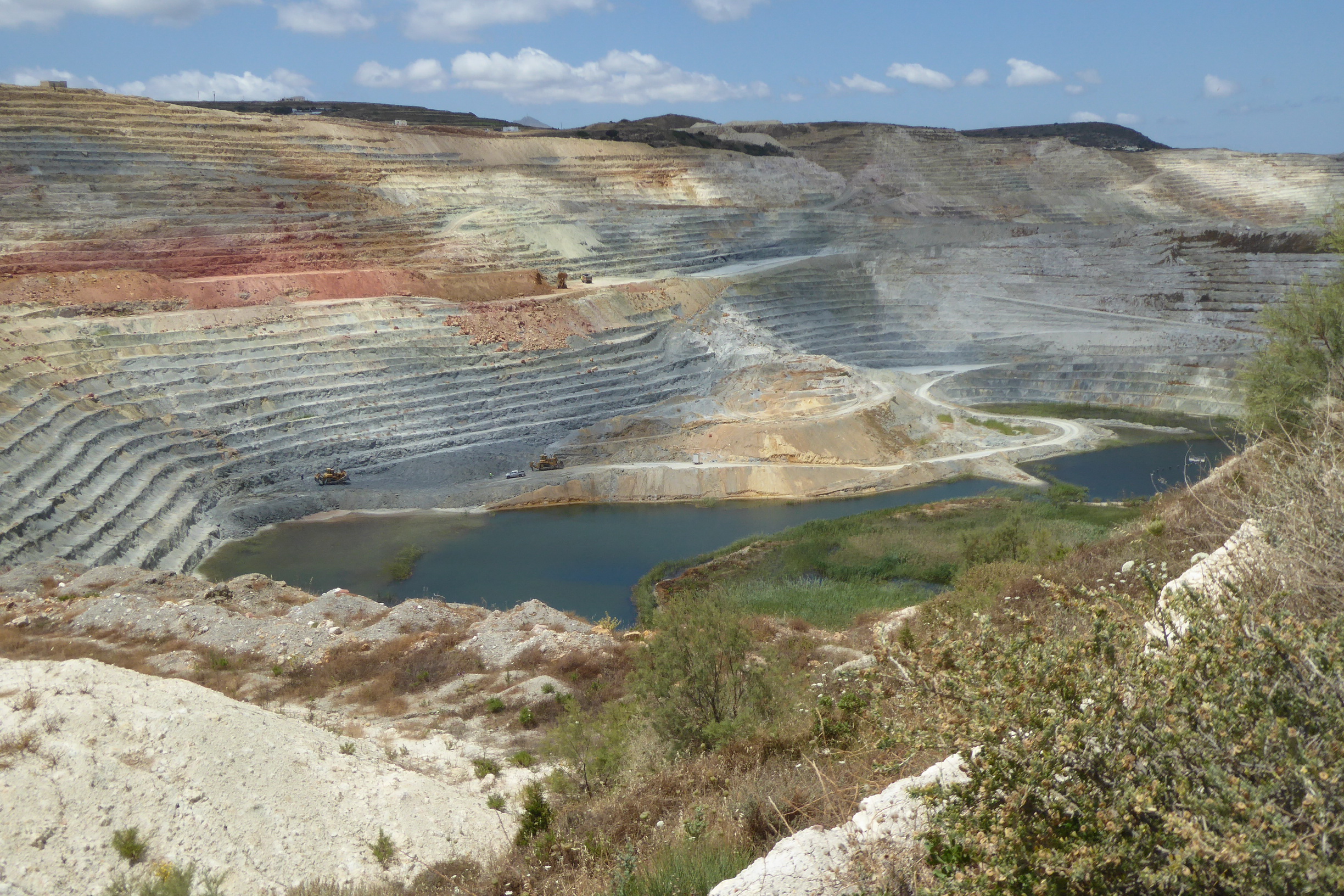 At one end of the island is the
However, we managed to turn the delay to our advantage, having been inspired
by a visit to the excellent little Mining Museum of Milos. It transpires that Milos is
virtually composed of minerals of every sort imaginable. From Neolithic times when
obsidian from Milos was exported across the Aegean, various minerals have been mined
ever since. Today Milos is one of the largest bentonite and perlite producers in the
world. We had a fascinating day in a little hired jeep (most of Milos' roads are dirt
track and off limits for ordinary cars) visiting disused and current mining operations –
marvelling at the fantastically colourful landscape – red, pink, orange, yellow, grey,
white and bizarre rock formations.
At one end of the island is the
However, we managed to turn the delay to our advantage, having been inspired
by a visit to the excellent little Mining Museum of Milos. It transpires that Milos is
virtually composed of minerals of every sort imaginable. From Neolithic times when
obsidian from Milos was exported across the Aegean, various minerals have been mined
ever since. Today Milos is one of the largest bentonite and perlite producers in the
world. We had a fascinating day in a little hired jeep (most of Milos' roads are dirt
track and off limits for ordinary cars) visiting disused and current mining operations –
marvelling at the fantastically colourful landscape – red, pink, orange, yellow, grey,
white and bizarre rock formations.  The Peloponnese looks entirely different to the Cyclades with
a greener landscape and an architecture of soft warm ochre colours. However, we weren't
done with walking up hills. Monemvasia is a mighty lump of rock attached to the land by
a bridge/causeway, looking like a mini Gibraltar. On this is an extremely quaint and
picturesque medieval village - a multi-dimensional tangle of narrow alleys – 'like
exploring someone's Minecraft' as Chris put it. We walked up to the top of the village –
but due to extensive repairwork, the path to the fortifications at the top of the rock
was closed – very disappointing!
The Peloponnese looks entirely different to the Cyclades with
a greener landscape and an architecture of soft warm ochre colours. However, we weren't
done with walking up hills. Monemvasia is a mighty lump of rock attached to the land by
a bridge/causeway, looking like a mini Gibraltar. On this is an extremely quaint and
picturesque medieval village - a multi-dimensional tangle of narrow alleys – 'like
exploring someone's Minecraft' as Chris put it. We walked up to the top of the village –
but due to extensive repairwork, the path to the fortifications at the top of the rock
was closed – very disappointing! 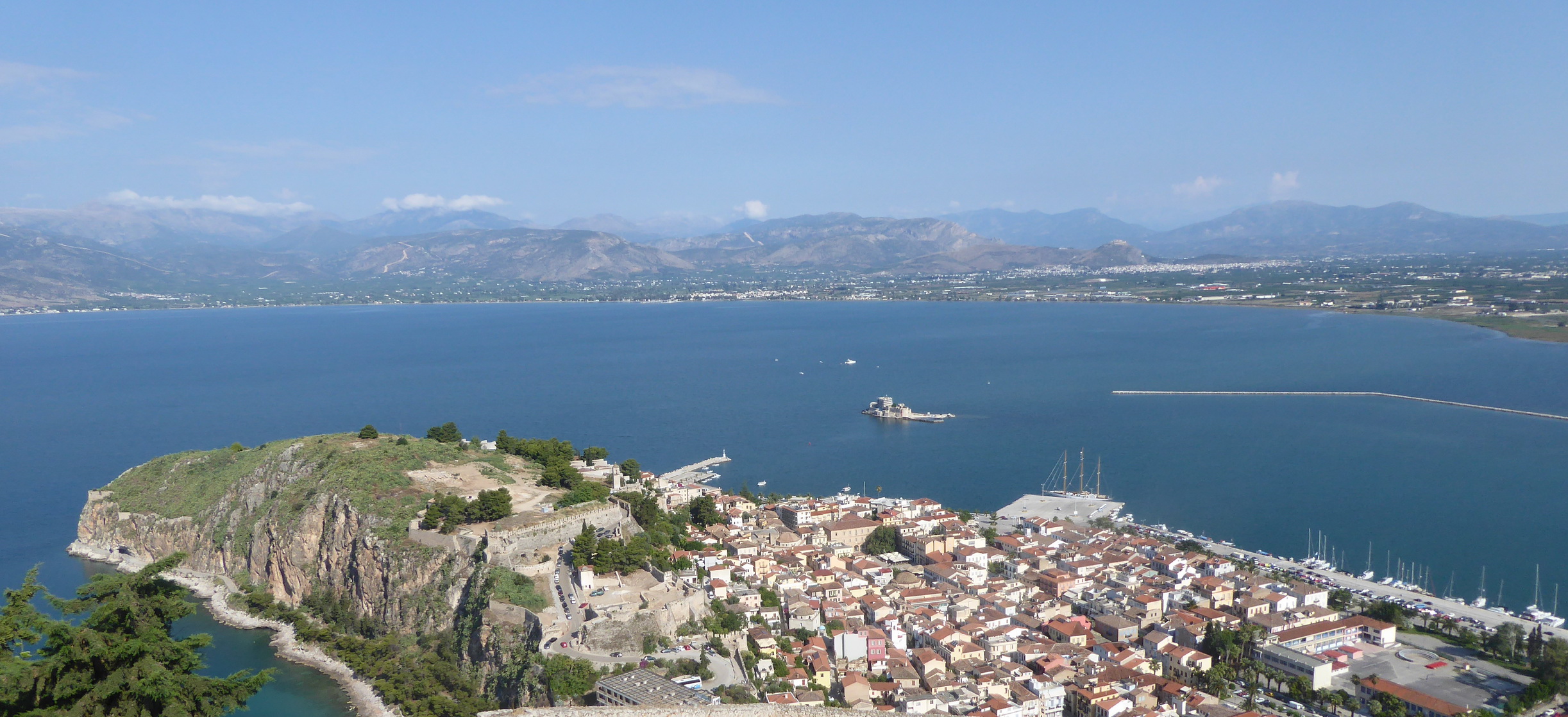 However, it
turned out to be not very yacht-friendly and not as useful as a pit-stop as we had
hoped, being difficult to locate such necessities as laundry, gas supplier – and even
the office to make payment for berthing. However, we have been to mighty Mycenae – the
remains of a once great ancient civilisation dating back 5,000 years – the site of
Agamemnon's palace and much Greek myth and legend of the time of the Trojan Wars. We
also climbed the 882 steps to one of Navplion's no less than three fortresses.
However, it
turned out to be not very yacht-friendly and not as useful as a pit-stop as we had
hoped, being difficult to locate such necessities as laundry, gas supplier – and even
the office to make payment for berthing. However, we have been to mighty Mycenae – the
remains of a once great ancient civilisation dating back 5,000 years – the site of
Agamemnon's palace and much Greek myth and legend of the time of the Trojan Wars. We
also climbed the 882 steps to one of Navplion's no less than three fortresses. 